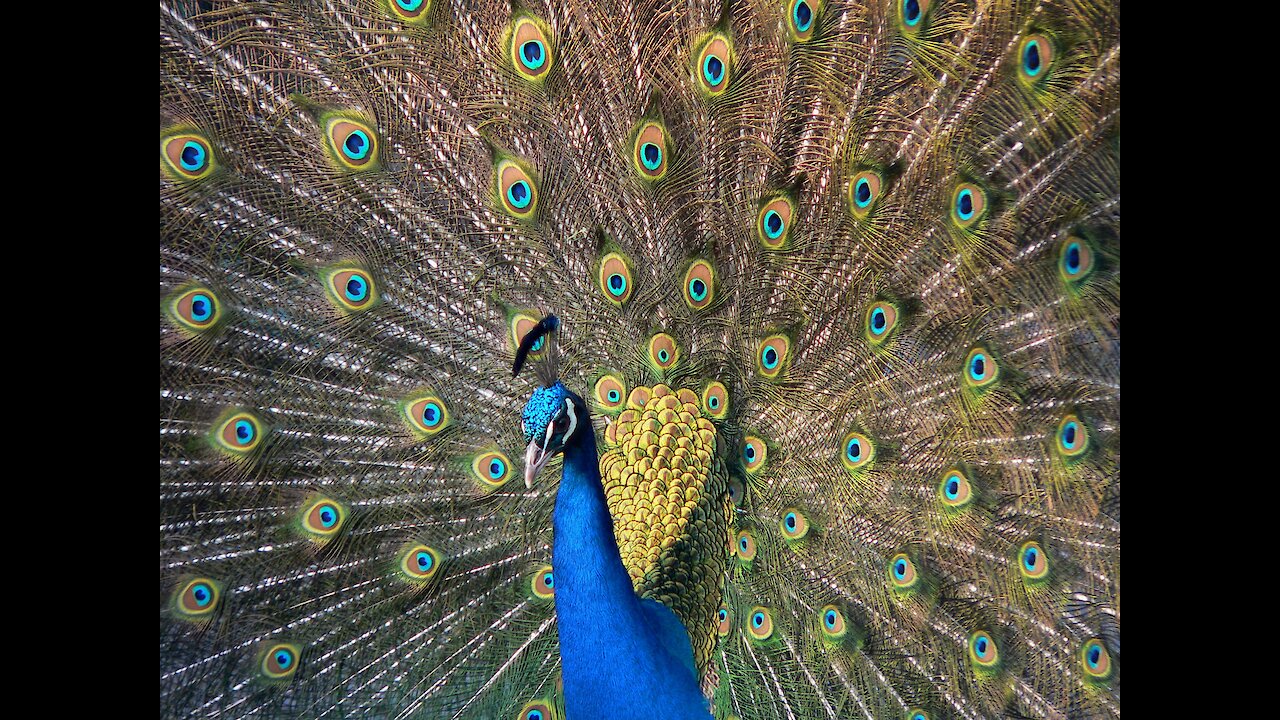Premium Only Content

Fabulous Indian Peafowl
Peacocks and peahens, these are the birds known as peafowl, members of the pheasant family. Although most people call the species peacocks, the word really only refers to the male bird. Just like among chickens, where the male is called a rooster or cock and the female is called a hen, male peafowl are peacocks, female peafowl are peahens, and babies are peachicks! There are two peafowl species: Indian or blue peafowl and green peafowl. Most people are familiar with the Indian peafowl, since that is the kind found in many zoos and parks.
The peacock has some of the brightest feathers and one of the most impressive courting displays of any bird in the world. The Indian peacock has very flashy plumage, with a bright blue head and neck, but the Indian peahen is a drab, mottled brown in comparison. The male needs his bright feathers to attract a mate, and the female needs to be able to blend in with the bushes so that predators cannot see her while she is incubating her eggs.
Unlike the Indian peafowl, the male and female green peafowl have similar coloration, although the peahen's colors are not as vibrant as the peacock's, and the male has a much longer tail. Green peafowl have green, rather than blue, feathers on the head and neck. Both Indian and green peafowl have bare patches of skin around their eyes and a funny crest on the top of their head made of feathers arranged in a fan shape. The Indian peafowl’s crest looks like little dots on the end of sticks!
The peacock’s back and belly have iridescent feathers in a scale pattern. But the thing that the Indian and green peacocks are best known for is—not the tail! These peacocks have a long “train,” which most people think is their tail. Actually, those long feathers are the male's tail coverts, or the feathers that cover the base of the tail. The train is covered in ocelli, which are round spots that look a lot like shining eyes.
It may seem that having such a long train and bright feathers would slow a peacock down and make him an easy target for predators like mongooses, jungle cats, stray dogs, leopards, and tigers—and this is absolutely true! However, if a predator grabs the train, the long feathers pull out easily, and the peacock can fly away.
When a peacock is in his second year, he grows his first train, but it has no ocelli and is not as long as a full-grown male’s. The train gets longer and more elaborate every year after that. At about five or six years of age, it reaches its maximum splendor. The peacocks that are the toughest—those that are able to survive long enough to have a really impressive train—are the ones that have the most mates and offspring. The coveted blue-eyed feathers of the train are dropped once a year; new feathers immediately begin growing and are completed a few months later.
Peahens seem to prefer males with the longest trains and biggest displays. In fact, the peacock’s female-attraction power is directly related to the perfection of his spectacular train, including its overall length, the number of iridescent “eyes” that are present, and even the symmetry of their patterning. It was the peacock’s train that apparently set Charles Darwin to thinking about the workings of how a special kind of natural selection he called “sexual selection” might operate and how a sense of esthetic beauty might have evolved, among birds AND humans.
A legend says that the peacock’s Creator gave it a horrible voice, lest its beauty make the bird overly conceited. Peafowl have 11 different calls, but the peacocks are the ones that really yell. They have a call that carries for a long distance and sounds like “may-AWE, may-AWE.” Some say the call sounds like a human crying for help! Peacocks call in the early morning and late evening, and practically all day during the breeding season.
In the past, wealthy people brought peafowl to their estates to strut about the grounds and look pretty. Then the peafowl reproduced and spread out into the surrounding areas. This caused problems in some places, because the peacocks made so much noise in the early morning that they became a real nuisance! Other animals don’t mind, though. With their sharp eyes, peafowl are likely to be the first to see a predator and call out a loud alarm.
-
 0:21
0:21
Beautiful_Animals_And_Birds
5 years agoA cute bunny sits on a plate
84 -
 LIVE
LIVE
Man in America
6 hours agoExposing the Cover-Up That Could Collapse Big Medicine: Parasites
911 watching -
 LIVE
LIVE
CHiLi XDD
2 hours agoTekken Fight Night
84 watching -
 LIVE
LIVE
ItsLancOfficial
7 hours agoFREAKY FRIDAY-GETTING FRIED-WELP! #TOTS
25 watching -
 1:09:11
1:09:11
Sarah Westall
3 hours agoRead the Signs: Are We Already Operating in a New Financial System? w/ Andy Schectman
9.96K1 -
 LIVE
LIVE
Flyover Conservatives
7 hours agoRicky Schroder Exposes How Hollywood Planted Him as a Child Star | FOC Show
808 watching -
 LIVE
LIVE
JahBlessCreates
1 hour ago🎉 TEKKEN TING, and maybe some music...
66 watching -
 LIVE
LIVE
GritsGG
2 hours agoTop 250 Ranked Grind! Dubulars!🫡
53 watching -
 LIVE
LIVE
StuffCentral
1 hour agoStar Stuffy
32 watching -
 6:02
6:02
Blackstone Griddles
3 hours agoPrime Rib Brisket Burgers on the Blackstone Griddle
140